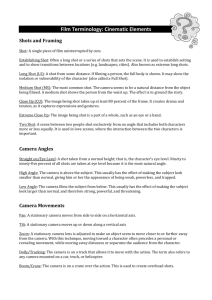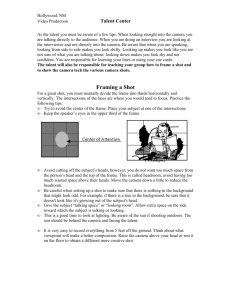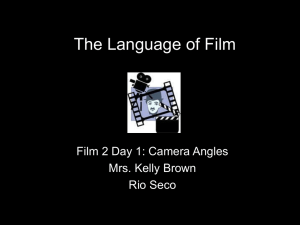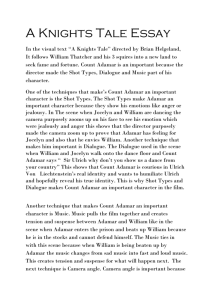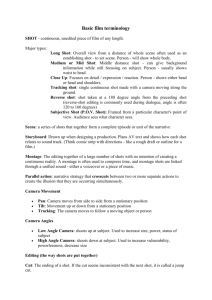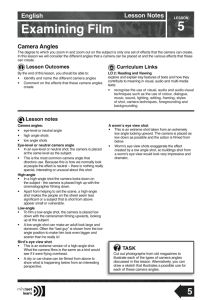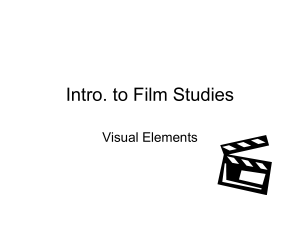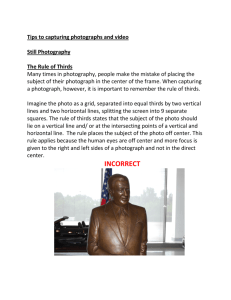Movement,_Shots,_and_Angles
advertisement
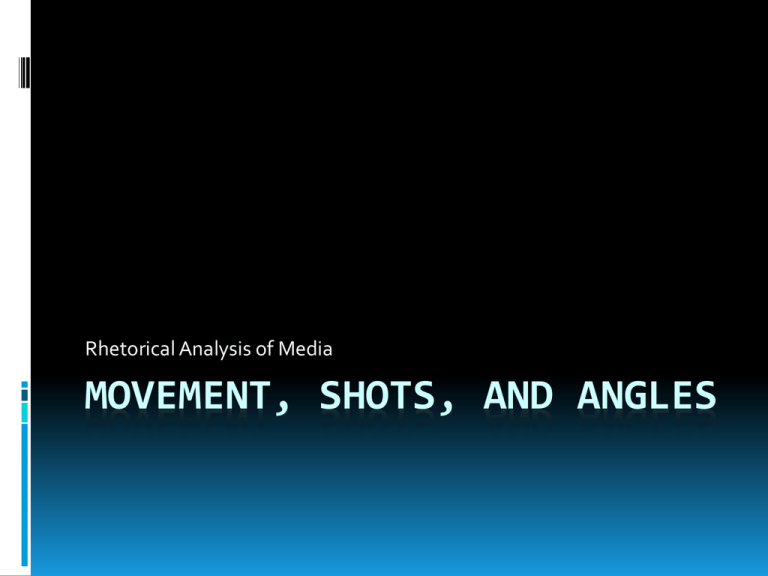
Rhetorical Analysis of Media MOVEMENT, SHOTS, AND ANGLES What is the story being told here? Mise-En-Scene Pronounced “mees-ahn-sahn” - ick Translation: “put in the scene” Everything that goes into a shot NOT editing/postproduction Let’s see another great example… Pay close attention: Mise-en-scene How does this scene play out? Why? What elements help support the story? Movement Early cameras were fixed, but today they move. Zoom The movement of an image only through the lens The camera doesn’t move, but the lens does. Allows the audience to move toward and away from images. Zoom IN & Zoom OUT Pan versus Tilt Each features movement along ONE axis PAN: The camera pivots left or right, left to right, or right to left on a horizontal axis Pan versus Tilt Each features movement along ONE axis TILT: The camera pivots up or down on a vertical axis Boom or Crane Shot The camera moves through the air The camera is lifted vertically with a boom or crane Shot A single length of film produced by continuous running of the camera Can be as short as one frame (example from The Graduate?) or as long as an entire film! Time Code Tracking Shot Also known as a “dolly” shot : each named for the mechanical devices used in filmmaking Tracking Shot Camera follows action through space The entire camera moves horizontally with, toward, or away from the subject Subject = focal point (character, object, landscape, etc.) Some Famous Tracking Shots A Touch of Evil: Orson Welles, 1958 Boogie Nights: Paul Thomas Anderson, 1997 Two Great Tracking Shots! 2006 - Alfonso Cuaron (Y tu Mama Tambien, Harry Potter and the Prisoner of Azkaban) Shot Size Shots are defined by the size of the subject within the film frame. A LOT can happen in one shot. The size of a subject can vary within a single shot. Long Shot Shows the entire figure Close Up Part of the subject takes up much of the entire screen Medium Shot The midpoint between long and close up It shows the body from about the waist up Extreme Close Up Part of the subject takes up all of the entire screen Medium Close Up Mid-point between Medium shot and Close up Extreme Long Shot Subject is fully seen in the distance of the shot Camera Angles Camera is usually at eye level, but can vary for particular effect Often Objective POV (though can be Subj. or Indirect-Subj.) Offers “normal” view of the world High Angle High angle - taken from above subject The Shining (1980) What effect does this image have on the audience? Low Angle Low angle - taken from below subject Equilibrium (2002) What effect does this image have on the audience? Add the word “EXTREME”… EXTREME HIGH ANGLE: Pink Floyd’s The Wall (1982) Add the word “EXTREME”… EXTREME LOWANGLE: The Shining (1980) The Camera is your FRIEND! Think about how you can manipulate it to striking effect in your own movie!



